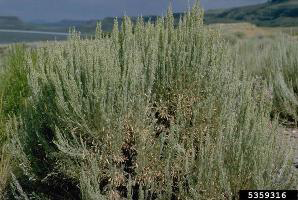Artemisia tridentata is one of the most widespread shrubs in North America. It is an important browse for wildlife, and food for birds, sometimes making up 100% of a species' diet during winter. It also is valuable for its cover and thermal properties for many birds. Sagebrush is Nevada's state flower.
Photo Credit: © Howard F. Schwartz, Colorado State University, Bugwood.org.
Artemisia tridentata
Common Name: big sagebrush
Plant Functional Group: Drought deciduous broadleaf
Class > Order > Family: Magnoliopsida > Asterales > Asteraceae
What does the species look like?
Big sagebrush is an evergreen, perennial shrub usually growing to 4 feet tall but ranging between 1.3 to15 tall. Numerous flowers occur along many stalks on the upper part of the plant. The cream-colored to yellow flowers are small and not very showy and each flower contains both male and female parts. Flowering begins when the plants mature at 2 to 3 years of age and the flowers are wind or self-pollinated.
Big sagebrush is a somewhat drought tolerant plant. It grows on a variety of soil types on arid plains, valleys, foothills, and mountains.
Where is the species found?
States & Provinces
AB, AZ, BC, CA, CO, ID, MA, MT, ND, NE, NM, NV, OR, SD, UT, WA, WY
Which phenophases should I observe?
Do you see...?
Leaves
Young leaves How many young leaves are present?
Less than 3 3 to 10 11 to 100 101 to 1,000 1,001 to 10,000 More than 10,000
Leaves More...
What percentage of the potential canopy space is full with leaves? Ignore dead branches in your estimate of potential canopy space.
Less than 5% 5-24% 25-49% 50-74% 75-94% 95% or more
Colored leaves More...
What percentage of the potential canopy space is full with non-green leaf color? Ignore dead branches in your estimate of potential canopy space.
Less than 5% 5-24% 25-49% 50-74% 75-94% 95% or more
Falling leaves More...
Flowers
Flowers or flower buds More...
How many flowers and flower buds are present? For species in which individual flowers are clustered in flower heads, spikes or catkins (inflorescences), simply estimate the number of flower heads, spikes or catkins and not the number of individual flowers.
Less than 3 3 to 10 11 to 100 101 to 1,000 1,001 to 10,000 More than 10,000
Open flowers More...
What percentage of all fresh flowers (buds plus unopened plus open) on the plant are open? For species in which individual flowers are clustered in flower heads, spikes or catkins (inflorescences), estimate the percentage of all individual flowers that are open.
Less than 5% 5-24% 25-49% 50-74% 75-94% 95% or more
Pollen release More...
How much pollen is released?
Little: Only a few grains are released. Some: Many grains are released. Lots: A layer of pollen covers your palm, or a cloud of pollen can be seen in the air when the wind blows
Fruits
Fruits Artemisia tridentata , the fruit is very tiny and seed-like and is crowded into a tiny spent flower head. The seed-like fruit changes from whitish-yellow or yellow-green to tannish and drops from the plant. Do not include empty flower heads that have already dropped all of their fruits.More...
How many fruits are present?
Less than 3 3 to 10 11 to 100 101 to 1,000 1,001 to 10,000 More than 10,000
Ripe fruits Artemisia tridentata , a fruit is considered ripe when it has turned tannish and readily drops from the spent flower head when touched. Do not include empty flower heads that have already dropped all of their fruits.More...
What percentage of all fruits (unripe plus ripe) on the plant are ripe?
Less than 5% 5-24% 25-49% 50-74% 75-94% 95% or more
Recent fruit or seed drop More...
How many mature fruits have dropped seeds or have completely dropped or been removed from the plant since your last visit?
Less than 3 3 to 10 11 to 100 101 to 1,000 1,001 to 10,000 More than 10,000
What do these phenophases look like?
There is currently no photoguide available for this species. If you'd like help us create one, use the guidance document and species template provided here . Then send it via email to education@usanpn.org when it is complete.
